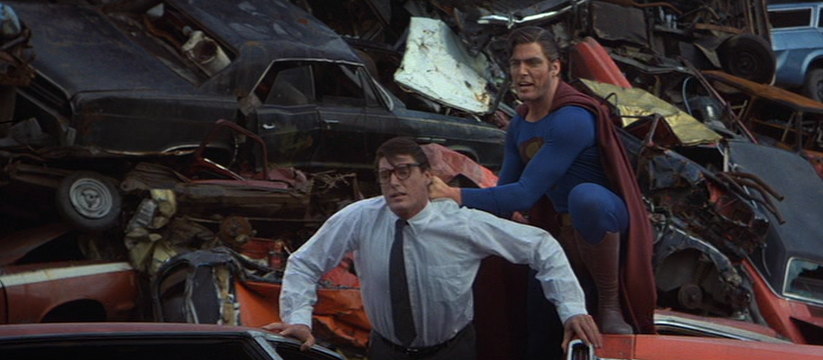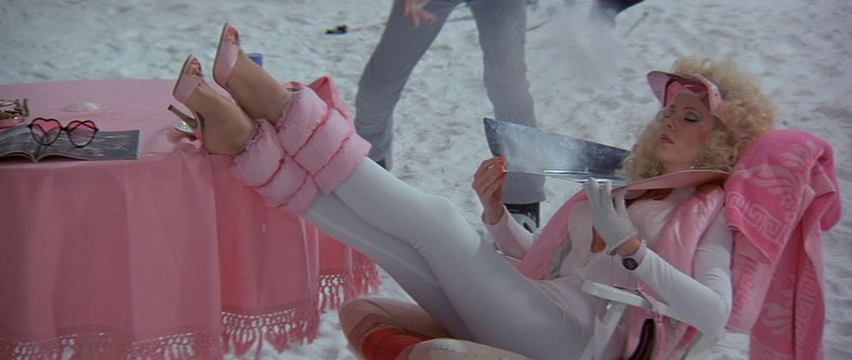

“Congratulations, old buddy. You’ll go down in history as the man who killed Superman!”
After the rocky production on Superman II, with its split directorial duties and script rewrites, Richard Lester was placed solely at the helm of the third installment. The camp aesthetic is turned up to a maximum and instead of continuing with the semi-serious take on the comic book hero that Richard Donner began with Superman, we are presented with a hodgepodge of comedy, sexual innuendo, and horror. There’s a distinct lack of a strong main villain and Lois Lane (Margot Kidder) only makes a cameo appearance, but the biggest oddity is the inclusion of comedian Richard Pryor, who gamely mumbles his way through the film as a genius computer wiz. It’s a step in the wrong direction, jettisoning many of the elements that made the first film memorable (and second one less so), but it has several of its own charms as well.
The plot is pretty shaky. Clark Kent (Christopher Reeve) travels to his hometown on assignment for the Daily Planet to cover his own high school reunion, where he is reunited with his high school crush Lana Lang (Annette O’Toole, who later portrayed Martha Kent in the television series Smallville). A villainous tycoon (Robert Vaughn), disturbed that Superman has thwarted his efforts to dishonestly grasp a monopoly on the world’s coffee supply, wishes to kill him, pulling in mastermind August Gorman (Pryor) as a reluctant helper. And toward the latter portion of the film, exposed to a lab-created pseudo-Kryptonite that contains tar (was this a metaphor for the dangers of smoking?), Superman turns into some kind of Bizarro-esque, evil version of himself.

The Smallville portion of the film is mostly fine, similar to the calmer scenes featuring Clark and Lois from the first two films. At the reunion, as the band is playing 1950s music, a song (“Roll Over Beethoven”) ends and a slower one begins. Everyone transitions to an upright form to dance slowly, but the large-bodied Clark (Reeve was 6’4”) continues shaking his booty as if he hasn’t realized the music stopped. But much of the other humor—slapstick, conversational hiccups, Clark accidentally eating dog food—is misplaced and hinders the film. There is some genuine effort to portray inner turmoil and drama here, notably when Clark is caught off guard upon learning that Lana is a single mother. The entire scene, set in the cluttered high school gymnasium the morning after the party, is well-constructed and acted. It’s even capped by an excellent long take.

Contrasting this interlude is the romantic side story between the tainted Superman and the chesty genius Lorelei Ambrosia (Pamela Stephenson), who poses as a bimbo and speaks likes she has breathed helium but reads Kant’s Critique of Pure Reason when no one is looking. They have one scene together in particular that is overwhelming in its suggestions. The two sit atop the Statue of Liberty, with Superman’s upper half offscreen as his midsection hovers incredibly close to Lorelei’s face and they exchange playful words. I suppose it would be considered tame nowadays, but since this film seems aimed more toward children than adults due to its campiness, it makes it a bit of a head scratcher and seems awfully unwholesome. A few moments later they meet atop the villain’s headquarters, a snow capped skyscraper in Metropolis. There, a small cottage sits at the bottom of a ski slope (yeah, it’s pretty campy stuff). Off screen, the relationship between Lorelei and Superman becomes horizontal. It reminds me more of Barbarella than anything related to Superman ever should. This is not to knock Stephenson’s performance, which I can’t imagine being better. In fact, she is one of the more memorable vixens of the era, channeling some of the silliness of the Batman television series while preceding Michelle Pfeiffer’s sexualized portrayal of the leather-clad, whip-toting Catwoman in Batman Returns. Her role, along with Pryor’s, are probably the most memorable in the film. They both do the most they can with the material they’re given, and turn what could have been drab into something that is at least silly.

The transition of Superman from the Man of Steel to the dingy, unshaven evil version of himself is visually compelling, and the effects team deserves credit for it. Likewise, Reeve pulls off quite a feat by portraying each of Clark, Superman, and evil Supe with enough nuance to differentiate the characters. The showdown between the tainted Superman and Clark Kent (which is depicted as physical but has to be playing out mostly inside of the character’s head à la Fight Club) is memorable and was likely a technical challenge to pull off in the early 1980s. But the villainous acts that the evil Superman commits are mostly silly, like blowing out the Olympic torch, flicking peanuts like bullets through glass bottles, etc. There is a solid moment of real terror when the tainted hero chooses to ignore a call for help to make an advance on Lana instead.
Taken at a glance, the film is largely innocuous; cheesy, campy fun that only feels removed from the benign super hero adaptations that came before Superman because of its excessive sexual themes. By the time we reach our ending we have entirely forgotten whatever mythos had been built up by the first two films. It’s a silly mishmash of scenes that seem pulled from a number of potential scripts, selected to maximize the use of Richard Pryor’s comedic abilities, Pamela Stephenson’s cleavage, and “cutting edge” computer technology. It’s weird, it’s silly, and much of it doesn’t work, while the best elements of it feel out of place in what purports to be a serious take on the character.